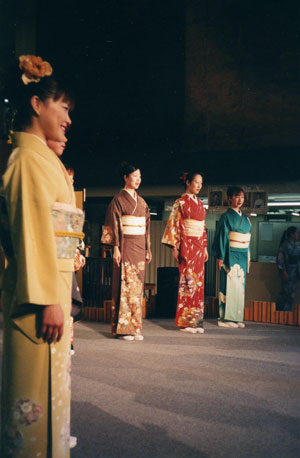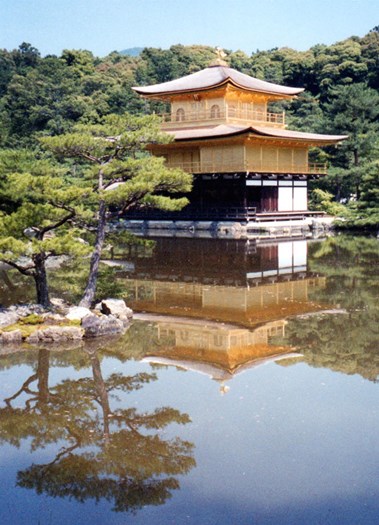KYOTO, JAPAN - I was led to believe Japan is a male-dominated world. So why is the tiny woman wrapped in silk wrappings, complete with a bow at the back, ordering me to take my shoes off before entering a hotel in this ancient city. Well, as I soon discover, this is no ordinary hotel. And the grandmotherly figure shouting orders is no ordinary woman. “We have slipper for you,” says the diminutive Akemi Nishimura as she glances down at my size 10 feet before shuffling off in search of footwear.
It is custom to remove one’s shoes before entering a Japanese home, and, as I discover, a traditional Japanese hotel, known as a ryokan, which dates back to 1880 and serves as this country’s answer to a guest house.
There are 70,000 such inns scattered across Japan and, while they differ in many ways, they all have one thing in common — each is managed by a woman.
Akemi Nishimura, the lovely elderly woman who has gone in search of my slippers, is the manager of Hiiragi-ya ryokan, one of the oldest in this city which served as Japan’s capital for more than 1,000 years.
Ryokans like this, while always popular with foreign visitors and elderly Japanese, have recently become the place of choice for Japan’s younger generation.
"They (Japanese parents) want their children to learn more about our traditions. So they send them to us and we give them an insight into our past," says the petite Nishimura, as she slides open the door to my room.
Before entering the large room that will serve as my home for the night, Nishimura tells me now to remove the slippers — no footwear of any kind is allowed past the threshold of these rooms.
The room is modestly furnished and the furniture is built low to the floor, in traditional style. My knees are already starting to ache at the thought of eating my meals with my legs crossed.
My curiosity gets the better of me so I ask Nishimura why only women can manage ryokans.
"It was decided that women, who entertained and served visitors in Japanese homes, would be best suited to run ryokans," says Nishimura.
"It’s a tradition that has been passed down from generation to generation and now my eldest daughter will soon be manager here."
The room is ringed with large floor-to-ceiling windows that look down on a small, neatly kept courtyard garden. There is no bed in the room, just a large table and some mats. A futon (the bedding of choice for traditional Japanese) will be brought to the room and rolled out on the floor before I retire.
Decorations are limited to some elegant brush drawings and scrolls on the sliding screen doors, called shoji. Like most ryokan rooms, mine comes with a thermal bath, where you jump into very hot water — most ryokans like this one are built over hot springs — to let your body absorb the soothing warmth.
Once the water revives your well-travelled body, you are invited to dress in a yukata — a Japanese nightgown — and relax in your room, where you are served a 14-course dinner (consisting of such raw fish treats as sea urchin and jellied squid, along with seasonal vegetables).
All this tradition comes at a price, of course. A night’s sleep — with breakfast and dinner included — can cost as much as 80,000 yen (about $800 U.S. a night). And, Nishimura admits, not everyone likes the traditional meals served here or the close-to-the-floor futon bedding.
"We make Western meals for those who want them and we have beds for people who don’t want to sleep on the floor," says Nishimura, who has played host to some of Hollywood’s biggest stars — Charlie Chaplin, Elizabeth Taylor and Robert Di Niro, to name just a few.
Most of the stars have signed her guest registry, which she proudly shows me.
It’s a pity some people pass on the traditional dinner. Kyoto cuisine, after all, has such a refined quality that it is recognized as an art form and the dishes served at Hiiragi-ya look too beautiful to eat.


Left: Women display silk creations in Kyoto. Right: The Golden Pagoda is Kyoto's most famous landmark.
The perfectly kept, but compact garden, which is accessible from ground-floor rooms, soothes the soul with a Zen-like experience.
This ryokan is more modern than most — with televisions, phones and even powered curtains all operated by a NASA-like remote control system.
"My husband (he’s the president of the company that owns the Hiiragi-ya ryokan) likes electronic gadgets," says Nishimura.
"He installed televisions here when they first came out in the 1950s and every time something new appears, like the powered drapes, he buys them."
There is much to see and do in Kyoto, a city of 1.5 million, which may have lost national capital status to Tokyo 1,100 years ago but remains the cultural epicentre of this fascinating country. In fact, this city, which became world famous with the signing of the Kyoto environmental accord, offers travellers 17 UNESCO World Heritage Sites, including Nijo Castle, built in 1603; Kinkakuji Temple, home of the world-famous Golden Pavillion, built in 1397 by Shogun (general) Ashikaga Yoshimirsu and Koudaiji Temple.
Nishimura employs 60 employees, many of whom are elderly and related in her 12-room inn.
After dinner, an attendant appears in my room and rolls out a futon. My back at first twinges at the thought of sleeping on the floor, but after eight solid hours of sleep, my fears were put to rest.
The next morning — I fear raw eggs will follow the raw fish we had the night before — I am surprised to see a more traditional North American breakfast of crisp bacon and fried eggs put before me.
After eating, Nishimura and three of her attendants accompany me to the door and continue bowing until my taxi pulls out of sight.
This is one hotel that should take a bow because it makes people feel so good.